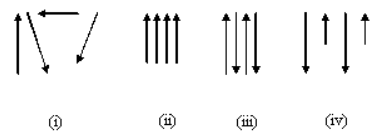Classify the magnetic materials into diamagnetic, paramagnetic, ferromagnetic and ferrimagnetic materials. Also give examples of each.
Classification of magnetic materials:-
Magnetic materials for that linear relationship in between M and H exists are divided in classes depending on the sign of χ (magnetic susceptibility). Materials that have negative value of χ the order of 10-4 to 10-6 are termed as diamagnetic and those that have a positive value of χ of about similar order of magnitude are termed as paramagnetic. When the relationship in between M and H is non-linear and shows hysterises effect, this group of materials wherein the resultant magnetization is one to some orders of magnitude. Such materials are called Ferromagnetic materials.
The other classification of magnetic materials contains in the presence or absences of permanent magnetic dipolar in them, Materials, that lack permanent magnetic dipoles, are termed as diamagnetic. When permanent magnetic dipoles are present in the atoms of a material, this may be ferromagnetic, paramagnetic, anti- ferromagnetic of ferrimagnetic depending upon the interaction among the individual dipoles. Therefore, if the interact between the atomic permanent dipoles moments is negligible or zero and the individual dipole moments are oriented at random as demonstrated in figure (i).

That material will be paramagnetic. If the dipole interacts in which a manner which they tend to line up in parallel, as demonstrated in figure (ii), the material will be ferromagnetic. If neighbouring moments are aligned anti parallel as demonstrated in figure (iii), the materials are anti- ferromagnetic. There is a large resultant magnetization, in ferromagnetic materials whereas in anti- ferromagnetic materials the magnetisation vanishes. While the order of the magnetic moments is as demonstrated in figure (iv), the phenomena is termed as ferrimagnetisms.
Illustrations of diamagnetic materials are Diamonds, copper and Graphite. Illustrations of paramagnetic materials are Ebonite and platinum and also Aluminium. Illustrations of Ferromagnetic materials are cobalt, Nickel and Iron.